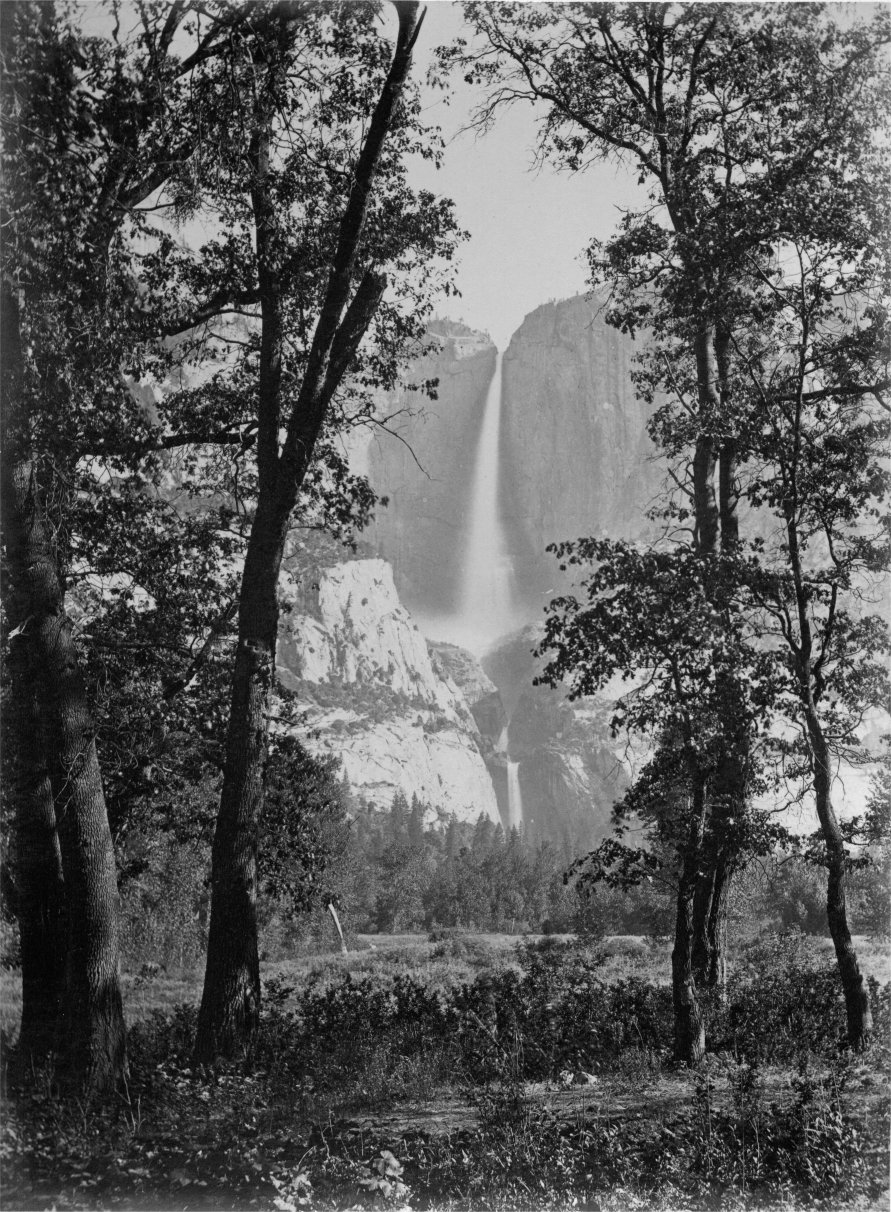
Yosemite > Yosemite Falls >

|
Yosemite Falls Heights | |||
|---|---|---|---|---|
| Fall | Feet | Meters | Comparison | |
| Upper Fall | 1,430 | 435 | Sears Tower, Chicago, Illinois | |
| Middle Cascades | 675 | 205 | ||
| Lower Fall | 320 | 98 | Length of a soccer field | |
| Total | 2,425 | 740 | Sears Tower plus Eiffel Tower, Paris, France | |
Rank:
Terminology Trivia:
The term falls is best used for waterfalls with multiple drops: Yosemite Falls, Sentinel Falls, Snow Creek Falls, etc. However, the term fall is more properly used when there is only a single drop: Upper Yosemite Fall, Lower Yosemite Fall, Vernal Fall, Bridalveil Fall, etc.
Flow and Volume:
Yosemite Creek has no gauging station for accurate flow measurements. Hydrologists have estimated an average spring flow of 300 cubic feet per second (cfs). There's approximately 8 gallons per cubic foot of water

The Yosemite Falls by Carleton E. Watkins, circa 1865-1866 from The Yosemite Book (1869). |
Principally snow melt feeds Yosemite Creek and Falls. A good proportion of this watershed is bare granite with limited soil and few lakes for water storage which would prolong a greater water flow into late summer and autumn. So it roars in spring and whimpers later in the season.
In contrast, the watershed of Bridalveil Fall maintains a greater flow later into the season although its watershed is approximately only 60% the size of Yosemite Creek's watershed. There are several reasons for this apparent anomaly:
Watershed Area:
Computed as area above brink of
Upper Fall.
Source: Jan VanWagtendonk, Research Scientist, using GIS
(Geographical Information System), March, 1991.
Brief Geology Story for Yosemite Falls:
Waterfall Heights:
The reason the tributary streams to the Merced River in Yosemite Valley have their great height above the valley floor (hanging valleys) is due to differential erosion. That is, the valley's rivers and glacierscut down into the rocks more quickly where the valley now lie, than did other tributary streams and glaciers. Tributary drainages were left behind at higher elevations. The valley was cut more deeply and quickly because:
Vertical Cliffs and Waterfall Alcoves:
Nearly all the sheer cliffs form where vertical joint systems allow rocks toflakeoff thus exposing relatively-clean, nearly-vertical surfaces. Rocks continue to flake off and the cliffs have receded significant distances since glacial times. The extra water (and winter ice) provided by tributary streams have greatly accelerated cliff recession where waterfalls pour over. All major falls in the valley have created their own recessed alcoves in a way that glaciers could never have carved such alcoves. Both Yosemite's Upper and Lower Falls sit in such recessed alcoves.
Why does Yosemite Falls have 3 levels or drops?
This is again due to joint systems (groups of linear cracks). This time the joints are running horizontally. Two horizontal joint systems interrupt the vertical joint systems. One horizontal joint system is near the base of the upper fall and the other near the brink of the lower fall. Therefore, vertical weaknesses (forming cliffs) meet horizontal weaknesses (forming benches). These two horizontal joint systems are clearly visible running both left and right away from the falls area a quarter mile or more. They are highlighted by the increased amount of vegetation that is encouraged by more ledges, cracks and soil at those locations.
Further Information
![]() Back to Yosemite, California Home
Back to Yosemite, California Home
![]() Copyright © 1997-2006 Dan Anderson. All rights reserved.
Copyright © 1997-2006 Dan Anderson. All rights reserved.
If you have questions or comments, please send a message to Dan Anderson.
http://www.yosemite.ca.us/yosemitefallsfacts.html